Lately I’ve been having a lot of conversations around investment terms with searchers, as well as investors.
About 15 years ago, I interned at a search fund. And, over the last few years, I’ve started to invest in the asset class going direct as well as through funds of search funds.
Investing in search funds is a great way to scratch my entrepreneurial itch, extremely rewarding when a searcher finds success, and can be economically rewarding too.
This post is my attempt to share thoughts on self funded search economics in an effort to contribute to the search fund community, get feedback on my thinking from a wider audience, and of course meet more people who are doing searches/investing and may want to collaborate (please feel free to reach out!).
You can watch a video of me explaining this model here, and download the excel here:

Enterprise Value
The standard finance equation is enterprise value = debt + stock – cash. Enterprise value is how much the company itself is worth. Many times people confuse it with how much the stock is worth and find the “minus cash” part of this really confusing.
So, you can rearrange this equation to make it stock = enterprise value – debt + cash. Make more sense now?
Enterprise value is just how much you’re willing to pay for the company (future cash flows, intellectual property, etc), not the balance sheet (debt and cash).
Most investors and searchers think about the EBITDA multiple of a company on an enterprise value basis because they’ll be buying it on a cash free, debt free basis. It becomes second nature to think about EBITDA multiples and know where a given business should fall given scale, industry, etc.
However, I believe this second nature way of thinking of things can be a massive disadvantage to investors given the way EV and multiples are talked about in our community currently.
Sources of capital, the typical way to calculate enterprise value for self funded searchers
If you’ve ever looked at or put together a teaser for a self funded search deal, you will notice that the deal value is equal to the sum of the sources of capital minus deal fees and cash to the balance sheet.
As a simple example, if there is $4 mm of debt to fund the deal, $1 mm of equity, and $200k of deal fees, the enterprise value = $4 mm + $1 mm – 200k = $4.8 mm.
We’ll use slightly more complex numbers in our example: If a searcher is taking a $3.2 mm SBA loan, $850k seller note, putting in $120k themselves, getting $350k of equity from the seller, a $500k earnout, and $1.2 mm of equity financing minus $350k to the balance sheet and $250k of deal fees, then the enterprise value will be $5.62 mm.
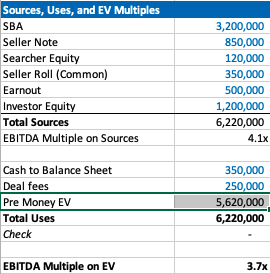
Our example company has $1.5 mm of EBITDA, so the EBITDA multiple is 3.7x. This is a pretty attractive acquisition multiple for a business that meets traditional search criteria (recurring revenues, fragmented competition, high gross margins, low customer concentration, etc).
If you’re seeing a search fund deal for the first time, the headline of “we’re buying a decent company for 3.7x, and replacing a tired owner with a hungry operator” is pretty exciting!
However, if you’re an investor, there is some nuance to this enterprise value number and the true EBITDA multiple you are investing in.
The trick with self funded enterprise value
The security that most self funded search investors get in a deal is participating preferred stock with a paid in kind dividend. This means when there’s an exit, you get your money back before any other equity holder, then get a certain percent of the business, and whatever dividend you’ve been owed in the interim accrues to your principle.
It’s a really favorable security for the investor, and one that is basically impossible to get in VC where straight preferred stock is much more common (no pun intended).
The key terms are what percent of common equity does this security convert into after the originally principal is paid back, and what is the dividend.
The share of common equity the investor group will get typically ranges from 10-50% of the total common stock. The dividend rate is usually 3-15%. The average I’m seeing now is around 30% and 10% for common and dividends respectively.
The strange this about the enterprise value quoted to investors in a teaser/CIM is that it doesn’t change as the percent of common changes, even though this has large implications for how much the common equity is worth and the value investors receive.
For example, I may get a teaser where the sources of investment – cash to balance sheet – deal fees = $3.7 mm for a $1 mm EBITDA company, which would imply a 3.7X EBITDA multiple. Let’s say the searcher is offering investors 30% of the common and a 10% dividend.
Let’s now say that the searcher is having a tough time raising capital and changes their terms to 35% of common and a 12% dividend. Does the effective enterprise value change for investors? I would argue yes, but I would be surprised to see it changed in the CIM/teaser.
This isn’t a knock on searchers or the search fund community. It’s just kind of how things are done, and I think this is mostly because it’s really hard to think about how the enterprise value has changed in this scenario.
However, the natural way of using EBITDA multiples to think about value for a business that is so common in PE/SMB can be extremely misleading for investors here. You may be thinking 3.7X for this type of business is a great deal! But, what if the security you’re buying gets 5% of the common?
If you’re in our world, you may counter this point by saying most searchers will also supply a projected IRR for investors in their CIM. However, IRR is extremely sensitive to growth rate, margin expansion, and terminal value. While the attractiveness of the security will be reflected, it can be greatly overshadowed by lofty expectations.
To get more clarity and have a slightly different mental model on the effective price investors are paying for this business, let’s go back to basics. Enterprise value should be debt + preferred stock + common stock – cash.
We know the values of each of these numbers, except the common. So, the main question here becomes: how much is the common equity worth?
Calculating value of common equity for self funded search funds
Equity value for most search fund deals = preferred equity from investors + the common equity set aside for the searcher and sometimes also advisors, board, seller.
We know that the preferred equity is investing a certain amount for a certain amount of common equity. The rub is that they are also getting a preference that they can take out before any common equity gets proceeds, and they are getting a dividend.
So, the exercise of valuing the common equity comes down to valuing the preference and dividend.
In my mind, there are three approaches:
- The discount rate method where you take the cash flows you’ll get in the future from the pref/dividends and discount them back at the discount rate of your choice. I am using 30% in my model which I believe accurately compensates investors for the risks they are taking in a small, highly leveraged investment run by an unproven operator. If you believe in efficient markets, this number also fits as it mirrors the historical equity returns as reported by the Stanford report, with a slight discount given this asset class has clearly generated excess returns relative to other assets on a risk adjusted basis, hence interest in these opportunities from an expanding universe of investors.
- The second method is to calculate how much money you’d get from your preference and dividends, taking into account that per the Stanford study around 75% of search funds will be able to pay these sums, and then discount these cash flows back at a rate more in line with public equities (7% in my model). This yields a much higher value to the preference/dividend combo, and therefore lowers the implied value of the common equity.
- The last method is to just say nope, there is no value to the preference and dividend. I need them and require them as an investor, but they are a deal breaker for me if they aren’t there, and therefore they don’t exist in my math. This of course makes no logical sense (you need them, but they also have no value?), but I’ve left it in as I think many investors probably actually think this way and it creates a nice upper bound on the enterprise value. Side note, as with obstinate sellers, jerk investors are usually best avoided.
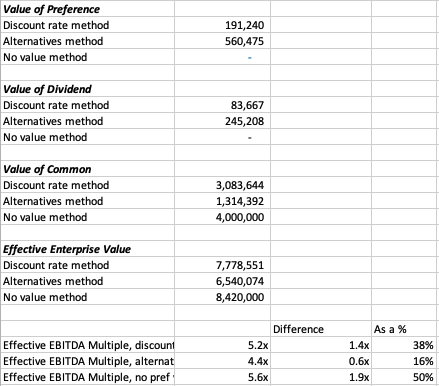
In our example, you can see a breakdown of the preference value, dividend value, and therefore common value and enterprise value for this deal.
In each case, the effective EBITDA multiple moves from 3.7x to something much higher (see the last 3 lines).
There are some simplifying assumptions in the model (no accruing dividend, all paid in last year), and some weird stuff that can happen (if you make the hold time long and the dividend greater than the 7% equity discount rate, the value of the dividend can get really big).
These flaws aside, I think this creates a nice framework to think through what the common is actually worth at close, and therefore what enterprise value investors will be paying in actuality.
It’s worth noting that the whole point of this is to benchmark the value you’re getting relative to market transactions in order to understand where you want to deploy your capital.
This creates a method to translate cash flow or EBITDA multiples of other opportunities on an apples to apples basis (if only there were a magical way to translate the risk associated with each as well!).
Another note, we could calculate the value of the common to be what this asset would trade at market today in a well run auction process minus any obligations (debt, preference, seller financing). However, I think that understates the option value inherent in this equity, a value that is only realized when a new manager takes over with more energy and know how.
There is a finance nerd rational for this. If you plot the value of equity in a leveraged company on a chart, it mirrors the payout of a call option. In both cases, the value of the security increases at a certain inflection point: when the value of equity rises above the strike price in an option, and when the enterprise value of a company rises above the debt level in a levered company.
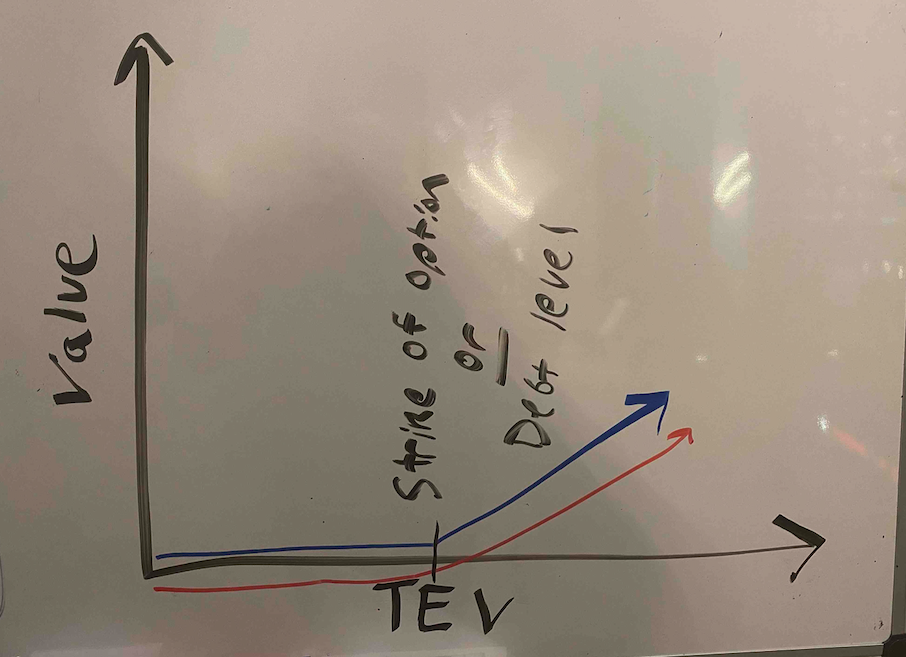
The common equity of a highly levered company can therefore be valued by a similar methodology as the call option: Black Scholes. If you remember back to finance class, increasing volatility will increase the value of an option.
In the search fund case, we’ve (hopefully) increased the (upside) volatility and therefore create more value than simply selling the company today.
A few more thoughts on investor economics
There are a few other ways to think about the economics you get as an investor to best understand if this is the deal for you.
First, you may want to think about how much your investment will be worth day 1. The key lever in this model is what discount this company is being bought for relative to fair market value. For example, the searcher may have proprietary sourced a great company and is buying it for 25% below what it would trade at in a brokered auction.
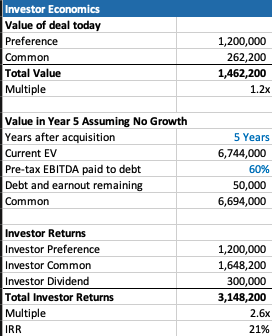
This is very much a “margin of safety” philosophy on things. Same with the calculation on how much you’ll receive in year 5 (after QSBS hits) assuming no growth in the business.
The only problem with each of these calculations is that they never play out in practice. Most companies don’t just stay the same, you’re either in a rising tide or you’re in trouble. And, you’re almost never going to sell in year 1, and definitely not for a slight premium to what it was bought for.
However, if your investment is worth 30% higher day one, and you can make a 20% IRR assuming nothing too crazy happens either way in the business, that’s not a bad place to start. Add in a strong searcher, decent market, some luck, and you’re off to the races.
Thoughts on searcher economics
A lot of this post has considered things from the investor perspective as my main quandary was related to how to create an EBITDA multiple that made sense for investors.
However, the point of this post is not to say searchers are misrepresenting or being unrealistic with their terms. In fact, I think it’s quite logical that self funded searchers capture the massive economic value that they do.
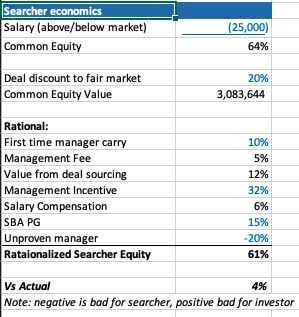
There are many reasons why self funded searchers deserve the lion share of the common equity.
First, they are providing a nice service of giving investors a positive expected value home to park their money with much lower correlation to the market than other asset classes ($1 mm EBITDA companies don’t see lots of multiple contraction/expansion throughout cycles).
Most money managers that fit that criteria are taking a 2/20, of course they also usually have a track record. So, I’ve used a 10% carry in my model, but stuck to 2% annual management fee.
The searcher spent a lot of time, and probably money, finding this company. That’s a lot of value, especially if it’s a below market price. They should be able to capture a lot of the value in finding a below market deal.
The searcher may be taking a below market salary, and needs to get comped like any CEO, with stock options. In my example model I have $1 mm of stock vesting over the hold period, as well as extra comp for taking a below market salary.
Searchers are also usually putting their financial standing at risk by taking a personal guarantee on the bank/SBA loan. This is really tough to put a number on, as is the last line in my framework where searchers are dinged for lack of experience. Like any good model, you need a few lines that you can fudge to make the math work 🙂
What you do think?
I’m shocked that I wrote all this. I was going to type a few paragraphs and a quick excel. However, putting this to paper has been a great exercise for me to sharpen my thinking.
Now I’d like you to help me further. Where do you think this should be changed in this framework? How do you think about things from the investor and/or searcher side?
Feel free to shoot me a note if you have thoughts (even just to tell me I’m being way too academic with this, which I actually agree with).
Lastly, a post like this is really a trap I’m putting on the internet to catch any like minded people in so that we can figure out ways to collaborate now or in the future. So, at the very least, connect with me on LinkedIn 🙂

I used to be recommended this blog by my cousin. I’m not certain whether this put
up is written through him as no one else recognize such unique
approximately my problem. You are incredible! Thanks!
If you wish for to get much from this post then you have to apply such methods to your
won webpage.
Wow, this article is pleasant, my sister is
analyzing these things, thus I am going to let know her.
Hi there colleagues, how is all, and what you desire to say regarding
this article, in my view its in fact remarkable designed for me.
Stunning quest there. What occurred after? Good luck!
My family every time say that I am killing my time here at web,
but I know I am getting familiarity every day by reading such good articles or reviews.
Its like you learn my thoughts! You appear to know a lot approximately
this, such as you wrote the book in it or something. I believe that
you simply could do with a few % to power the message house a little
bit, however other than that, that is fantastic blog.
An excellent read. I’ll certainly be back.
Thank you for the auspicious writeup. It in fact was a amusement account it.
Look advanced to far added agreeable from you!
However, how can we communicate?
Hello there, You have done a fantastic job. I’ll certainly digg it and personally
recommend to my friends. I’m sure they’ll be benefited from this
website.
Someone necessarily assist to make severely posts I might state.
This is the very first time I frequented your website page and up to now?
I amazed with the research you made to make this actual put up extraordinary.
Magnificent activity!
This website was… how do you say it? Relevant!! Finally I have found something that
helped me. Many thanks!
After looking into a few of the blog articles on your website, I
honestly appreciate your technique of writing a blog.
I book marked it to my bookmark site list and will be checking back in the near future.
Please visit my web site too and tell me what you think.
Superb post but I was wanting to know if you could write a
litte more on this subject? I’d be very grateful if you could
elaborate a little bit further. Thank you!
When I originally commented I clicked the “Notify me when new comments are added” checkbox and now each time a comment is added I
get three e-mails with the same comment.
Is there any way you can remove me from that service? Thanks!
Link exchange is nothing else however it is
only placing the other person’s website link on your page at appropriate place and other person will also do similar in support of you.
Hey there! This is my first comment here so I just wanted to give a quick shout out
and say I really enjoy reading through your blog posts.
Can you suggest any other blogs/websites/forums that cover the same topics?
Thanks for your time!
Thanks for one’s marvelous posting! I really enjoyed
reading it, you might be a great author. I will remember to
bookmark your blog and definitely will come back very soon. I want to encourage you continue your great work, have a nice evening!
We’re a group of volunteers and starting a new scheme in our community.
Your site provided us with valuable info to work on. You’ve done a
formidable job and our entire community will be grateful to you.
Hello, the whole thing is going well here and ofcourse every one is sharing information, that’s really excellent, keep up writing.
Highly descriptive article, I enjoyed that a lot.
Will there be a part 2?
bookmarked!!, I really like your website!
Thanks for your marvelous posting! I seriously enjoyed
reading it, you can be a great author.I will ensure that I bookmark your blog and definitely will come back at some point.
I want to encourage that you continue your great job,
have a nice afternoon!
Excellent post. I used to be checking constantly this blog and I’m inspired!
Extremely helpful info specially the ultimate section 🙂 I maintain such info a lot.
I used to be looking for this particular information for a very
long time. Thanks and best of luck.
I’ve been surfing online more than 3 hours today, yet I
never found any interesting article like yours. It’s pretty worth enough for me.
In my opinion, if all webmasters and bloggers made
good content as you did, the internet will be a lot more useful than ever before.
Howdy! I just want to give you a huge thumbs up for your great info
you’ve got here on this post. I’ll be returning
to your website for more soon.
I’m now not certain the place you’re getting your info, however good topic.
I must spend a while studying much more or working out more.
Thank you for fantastic info I was in search of this
info for my mission.
Now I am going to do my breakfast, after having my breakfast coming again to
read more news.
Appreciate this post. Will try it out.
continuously i used to read smaller articles or reviews which also clear their motive, and that is also happening with this paragraph which I
am reading here.
If some one wants to be updated with most recent technologies after that he must be go to see this web page and be up to
date all the time.
My programmer is trying to persuade me to move to .net from PHP.
I have always disliked the idea because of the expenses.
But he’s tryiong none the less. I’ve been using Movable-type on numerous websites for about a year and
am concerned about switching to another platform.
I have heard very good things about blogengine.net.
Is there a way I can import all my wordpress posts into it?
Any help would be really appreciated!
You’re so awesome! I do not suppose I’ve read a single thing like that before.
So great to find someone with genuine thoughts on this subject.
Seriously.. many thanks for starting this up.
This web site is one thing that is needed on the internet, someone with a little originality!
Great blog here! Also your web site loads up very
fast! What web host are you using? Can I get your affiliate link to your host?
I wish my site loaded up as quickly as yours lol
Howdy! I know this is kind of off topic but I was wondering which blog platform are you using for this site?
I’m getting sick and tired of WordPress because I’ve had issues with hackers and I’m
looking at alternatives for another platform. I would be awesome if you could point me in the direction of
a good platform.
My family members every time say that I am killing my time here
at net, but I know I am getting know-how all the time by reading such
good posts.
You really make it appear really easy with your presentation however I
in finding this topic to be really one thing that I
feel I might by no means understand. It kind of feels too complicated and extremely huge for me.
I’m looking ahead to your subsequent put up, I will try to get the hold of it!
Saved as a favorite, I really like your site!
Hello my friend! I wish to say that this post is amazing, great written and include approximately all important infos.
I’d like to peer extra posts like this .
I’m really enjoying the theme/design of your web site.
Do you ever run into any web browser compatibility
problems? A handful of my blog visitors have complained about my website not
operating correctly in Explorer but looks great in Safari.
Do you have any recommendations to help fix this problem?
Hey there! I’m at work browsing your blog from my new
iphone 3gs! Just wanted to say I love reading through
your blog and look forward to all your posts! Carry on the superb work!
Good answers in return of this difficulty with firm arguments
and describing the whole thing about that.
I am really loving the theme/design of your web site. Do you ever run into
any internet browser compatibility problems? A handful of my blog readers have complained
about my site not operating correctly in Explorer but looks great in Firefox.
Do you have any solutions to help fix this problem?
Somebody necessarily help to make significantly articles I’d state.
That is the first time I frequented your web page and to
this point? I amazed with the analysis you made to make this
particular submit extraordinary. Fantastic task!
Do you mind if I quote a couple of your posts as long as I provide credit and sources back
to your website? My blog is in the very same area of interest
as yours and my users would really benefit from a lot of the information you present here.
Please let me know if this ok with you. Many thanks!
My spouse and I stumbled over here different web page and thought I might as well
check things out. I like what I see so now i’m following you.
Look forward to checking out your web page for a second time.
It is perfect time to make a few plans for the longer term and it’s time to be happy.
I have read this publish and if I may just I want to counsel you
few fascinating issues or tips. Perhaps you could write next articles relating to
this article. I desire to learn even more things about it!
No matter if some one searches for his necessary thing,
so he/she desires to be available that in detail, thus
that thing is maintained over here.
I like the helpful info you provide in your articles.
I’ll bookmark your blog and check again here regularly.
I’m quite sure I’ll learn plenty of new stuff right
here! Best of luck for the next!
Great blog here! Also your website loads up fast!
What web host are you using? Can I get your affiliate link to your
host? I wish my website loaded up as quickly as yours lol
What a information of un-ambiguity and preserveness of precious familiarity about unpredicted feelings.